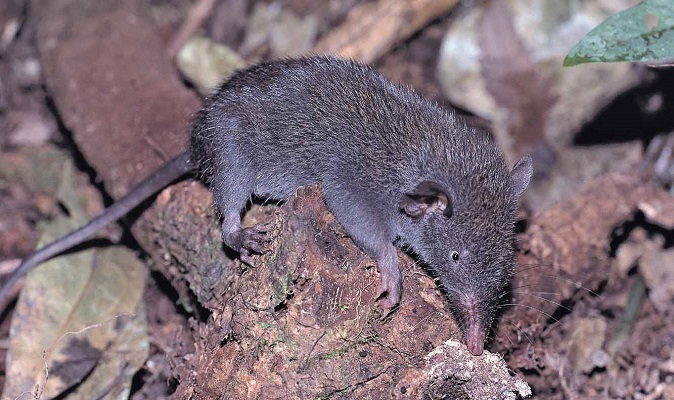
Gracile Shrew Tenrec (Microgale gracilis) - Anjanaharibe - Madagascar - Copyright Harald Schütz
Back to Tenrec Resources and Information
by David G. Kupitz, Bünde, Germany. Published April 5, 2020. Updated April 11, 2020.

Gracile Shrew Tenrec (Microgale gracilis) - Anjanaharibe - Madagascar - Copyright Harald Schütz |
Taxonomy
| Family: Tenrecidae | Tenrecs |
|
Subfamily: Oryzorictinae |
Furred Tenrecs |
|
Genus: Microgale |
Shrew Tenrecs |
|
Species: Microgale gracilis |
Gracile Shrew Tenrec |
Malagasy name: none known
Description
A largish shrew tenrec with a total length of 160 to 187 mm and a tail shorter than the head-body length. Its head-body length is 88 to 106 mm and its tail length is 60 to 87 mm. Its average weight is approximately 22 g. The upperparts are dark brown with buff speckles. The underparts are grey with a buff wash. The tail is dark grey or dark brown dorsally and light grey of light brown ventrally. Juveniles appear to be less speckled than adults, particularly around the rump. The head is elongate and gracile. The muzzle is very large and long and has reticulated striae on its distal portion. The dentition is reduced, both incisors and canines are very slender. Its eyes and ears are small and partially obscured by the pelage. The hindpaws end in long claws (Garbutt, 1999; Soarimalala & Goodman, 2011).
Similar species
M. gracilis and M. gymnorhyncha are similar, but M. gracilis is generally larger. The muzzle of M. gracilis has reticulated striae while that of M. gymnorhyncha has transversal striae (Soarimalala & Goodman, 2011).
Behaviour and Natural History
Based on morphological features like its elongate muzzle, reduced eyes and ears and broadened feet with large claws, this species appears to be semi-fossorial.
Reproduction
No details are known.
Distribution

Range of Microgale gracilis. IUCN Red List of Threatened Species, species assessors and the authors of the spatial data. / CC BY-SA (https://creativecommons.org/licenses/by-sa/3.0)
M. gracilis is found in the north in the Marojejy-Anjanaharibe-Sud complex, on the central high plateau and on the eastern escarpment south until Andohahela (Parcelle 1). It is known from between 800 and 2,000 m of altitude.
Habitat
The species occurs in relatively intact evergreen rainforests from the upper limits of lowland forest up to mountain rainforest. The species has also been found in montane sclerophyllous forest. It has also been collected in significantly degraded habitat close to the forest edge.
Conservation Status
Classified as Least Concern (LC) by the IUCN in view of its wide distribution, presumed large population, as it occurs in a number of protected areas (Marojejy National Park, Ranomafana National Park, Andringitra National Park, Pic d'Ivohibe Special Reserve, Andohahela National Park) and as it is unlikely to be declining fast enough to be listed in a threatened category. Nevertheless, the population abundance of this species is not known. It may be difficult to trap. There appear to be no major threats to this species, or its habitat, within its elevational range. The current population trend is deemed to be decreasing by the IUCN (Stephenson et al., 2016).
References
GARBUTT, N. (1999): Mammals of Madagascar. Yale University Press, New Haven and London. 320 pages. ISBN 1-300-07751-3.
SOARIMALALA, V. & GOODMAN, S. M. (2011): Les petits mammifères de Madagascar - Guide de leur distribution, biologie et identification. Association Vahatra, Antananarivo, Madagascar. 176 pages. ISBN 978-2-9538923-1-4.
STEPHENSON, P. J., SOARIMALALA, V. & GOODMAN, S. (2016): Microgale gracilis. The IUCN Red List of Threatened Species 2016: e.T13343A97191617. http://dx.doi.org/10.2305/IUCN.UK.2016-1.RLTS.T13343A97191617.en. Downloaded on 5 April 2020.